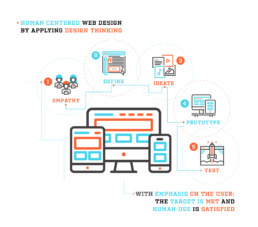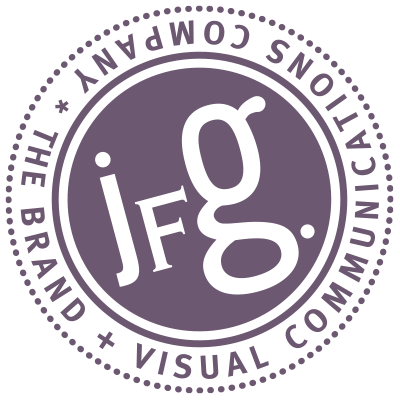Apply Human Centered Web Design with Design Thinking
Designing a website that’s relevant and effective for your business is a challenge. To be successful, you have to ask questions, gather feedback, and analyze the answers before you can create.
Human-centered web design is a form of design which focuses on the experience of the user. Human-centered web design asks why a website exists, what is its purpose, and what are the goals. Therefore, the object is to design the site in such a way that the target is met, and human-use is satisfied. This slightly different approach where as user-centered design, the main objective is to design a website that is functional. Human-centered design becomes functional, yet is accomplished by taking care of all needs to fulfill the website’s purpose to serve its users. But how is this done and how do you apply it to entice return visitors?
By applying design thinking, you can help answer these questions. Design thinking succeeds by identifying and solving problems by using an iterative approach to the design process: defining problems, finding solutions, testing and evaluating those solutions, and going back to the drawing board to come up with more ideas and make more improvements. I spoke of this topic last year in my blog post, “adapt and recover, not fail”
With design thinking, the focus is on the visitors to the site and their particular needs. By empathizing with the visitors, i.e., your clients, you can better understand their needs and effectively fulfill them. Design thinking consists of five essential components: Empathize, Define, Ideate, Prototype, and Test. Let’s take a look at these five steps and apply them to how you might create or rebrand a human-centered website.

1. Let’s Start with Empathy
When you have empathy, you understand and share the feelings of others. How can you truly know and understand these feelings unless you directly ask them the questions? You can’t assume or think you know what is best, because assumptions tend to produce bad results.
At the start of the project, it’s essential to ask all the questions, cover all the bases, and learn as much as possible about your ideal client, i.e., their business, their pain points, and the solutions in which they are looking. Yes, you do have to think about possible scenarios for bringing eyes to the site and keeping them there, but first, you must know who your ideal client is, and figure out what they like and need.
Creating personas is a way to do this. Create the qualities of a person who’s your ideal customer. Then interview actual people that match these qualities. It is vital to gather real data. Take in their feedback and use it to improve upon or highlight the qualities or services that your ideal client is looking for and that you can offer.
2. Define All the Challenges
Now that you have gathered feedback from your users, define the problem. In this case, let’s say that you want to convince visitors to return to your site for a second or third look. What strategies can you use? Yes, you asked them to sign up for the newsletter, but what else can you implement to bring them back? Depending on your client’s need or pain points, it might be educational content, go-to videos, or participating in an upcoming event or webinar.
Whatever problem you decide to tackle, make sure it is well-defined and achievable. If necessary, separate the more substantial issues into smaller ones and tackle them one at a time.
3. Ideate the Possibilities
Now that you have completed the research on your ideal visitor and defined their problems, it’s time to create a strategy for action. Using empathy you gained through your research, approach the problem from different angles. Remember that you’re designing the best solution for your visitors, not for you. Thinking this way will help you discover creative solutions that are more effective as well. This is the time to be as creative as you can be, don’t hold back and go beyond the box.
What are the ideas that come to mind? Come up with as many as you can think of, the sky’s the limit. Go beyond the obvious, is there an idea that you think that would fit best?
4. Prototype the Journey
Now, take your list of ideas and try them out. Build out smaller versions of each potential solution. This allows you to test several ideas instead of committing all of your time and energy into something that is untested and might not work. If needed, go back to the ideation phase to come up with new ideas based on what you learn from your prototypes. Through your evalutation of your prototypes, valid solutions unfold.
5. Select the Best and Test
Once you’ve realized a possible solution, use the tools available to you to evaluate its effectiveness. You could do this easily by using analytics tools, such as Google Analytics. After you’ve tested and evaluated your results, if the problem needs some more work or a different solution, return to the ideation or prototyping phase. If you consider the problem solved, return to the define phase and begin work on a new issue.
The Best Experience for the User
Using Human-centered web design with a design thinking approach helps you tailor the website experience to your user, presenting them with a smooth, helpful, and pleasant experience. Remember, this is an ongoing process that you must repeat consistently. It isn’t a one-time fix and done. As with anything, you have to keep trying and growing and trying again to see long-term results, but if you create the journey and continue to improve upon it, you will foster engagement with your content and convert website visitors into loyal clients.
Are you looking to apply human centered design to your website? I am here to help.
BRAND ESSENTIALS FOR THE ENTREPRENEUR
Read more about branding, strategy, and visual communications.
JFG VISUAL COMMUNICATIONS
Are you ready to elevate your business to the next level?
Regardless if you’re in the starting phase of your business or in the position to take your start-up to the next level, you don’t have to do it alone. Learn more by scheduling a complimentary 30-minute consultation and let's get started today!




